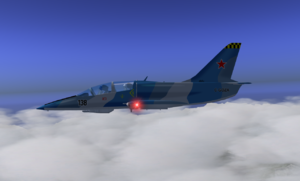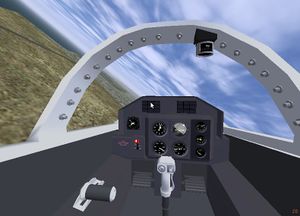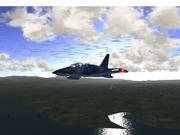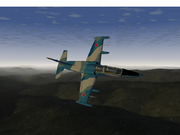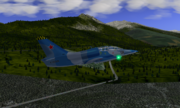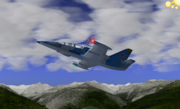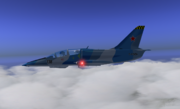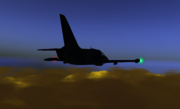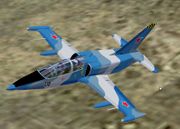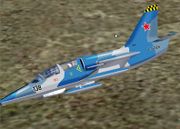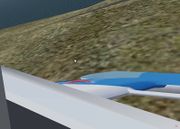The Aero Vodochody L-39 Albatros is a high-performance jet trainer aircraft developed in Czechoslovakia to meet requirements for a "C-39" during the 1960s to replace the Aero L-29 Delfín. It was the first turbofan-powered trainer produced. Production began in 1971 and ended in 1999, and over 2800 L-39's are still in use today, some in private hands.
Review
| This section contains a review. Please note that statements made here are (mostly based on) a single person's opinion.
|
The FlightGear version of this aircraft tested (l39_20101217 from FlightGear Aircraft Version 2.6 download page) is a neat, attractive model, though lacking some polygons.
Take - off was at about 200 mph. A right wing drop accompanied take off due to over-controlling of the aircraft with its sensitive ailerons, and brisk climb was made upto just beneath the clouds. A quick roll to the right confirmed the guess that the ailerons were very sensitive, and an overcorrection after the roll had us headed for the valley in the wrong way.
The first landing in what seemed an empty flat field seemed a long affair despite full brakes. The undercarriage, operated by a neat lever and three red lights that are on all the time when the gear is up and locked - warning lights are usually the only lights that are on all the time and red- usually means something is very wrong, but in this case all was well - was lowered and a high speed landing was made in the nick of time.
A subsequent landing was much better after testing stall speeds at 5000 ft, with 2 notches of flaps as well as without flaps. Approach was made at 200 mph with flaps and gear (the dial is marked in mph) and the L-39 slowed nicely on reducing power over the threshold. Touch down was achieved at about 180 mph, and at 200 fpm descent, with some rudder to correct for the drift and braking brought the aircraft to a stop quickly.
The cockpit is very neat, as great visibility and is very clean throughout. The model itself is squarish from certain angles, but the attractive camouflage scheme more than makes up for it.
Tested Instruments
- Horizontal Situation Indicator (HSI)
- Air Speed Indicator (ASI)
- Vertical Speed Indicator (VSI)
- Altimeter (ALT)
- Compass
Compatibility
- FloghtGear 1.0.0: **WORKING**
- FlightGear 1.9.1: **WORKING**
- FlightGear 2.6.0: Listed on Download page
- FlightGear 2016.x Listed on Download page
Speeds
Real V speeds:
- V2: 150mph
- VNE: 608mph
- Vs: 200mph
- Vso: 150mph
Speeds as tested in FlightGear:
- VNE: 450 mph
- Approach : 150 mph
Gallery
| An L-39 Albatros taking off.
|
| The L-39 demonstrating its acrobatic capabilities.
|
| An L-39 Albatros taking off from LSGS.
|
| Climbing over the Swiss Alps.
|
| An L-39 flying over the Alps.
|
| Flying at sunset over the Swiss Alps.
|
| L39 in flight in FlightGear 1.0
|
| Looking over the edge of the cockpit in the L-39
|
|

